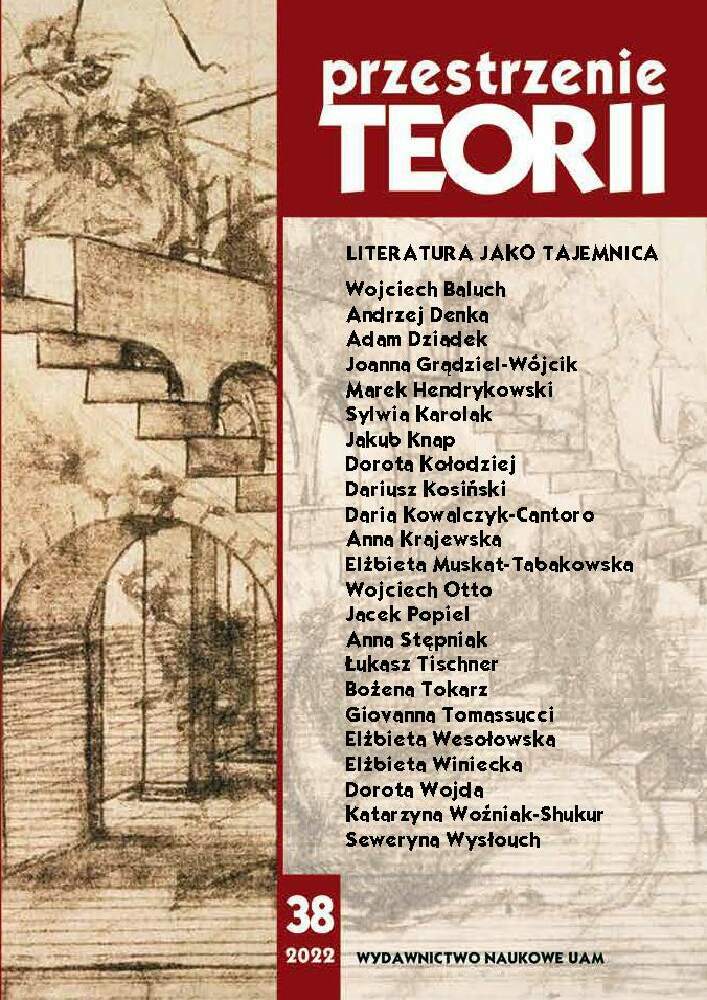Abstract
The article discusses the phenomenon of multiple reading of literary hypertexts. The construction of electronic hypertext is conducive to creating uncertainty and generates both: story and structural puzzles. The author on the example of the afternoon. a story by Michael Joyce discusses the characteristics of this type of literary works, which by involving the reader in the process of creating the course of the plot, put him before new challenges. Hypertext multiplies questions and riddles, plays with suspense as a ploy that promises a solution, and delays the fulfillment of the promise indefinitely. At the same time, it refers to solutions known from twentieth-century experimental novels.
References
Aarseth E., Cybertekst. Spojrzenia na literaturę ergodyczną, przeł. M. Pisarski, P. Schrei
Bal M., Narratologia. Wprowadzenie do teorii narracji, przekł. zesp. pod red. E. Kraskowskiej, E. Rajewskiej, Kraków 2012, s. 165.
Barthes R., S/Z, przeł. R. Miller, New York 1974.
Bartoszyński K., O lekturze wielokrotnej, „Pamiętnik Literacki” 1990, 81/4, s. 145–166.
Bernstein M., On hypertext narrative, [w:] HT ‘09: Proceedings of the 20th ACM conference on Hypertext and hypermedia, New York 2009, s. 4.
Brewer W.F., The nature of narrative suspense and the problem of rereading, [w:] Suspense: Conceptualizations, Theoretical Analyses, and Empirical Explorations, red. P. Vorderer, M.C. Wulff, Oxfordshire 1993.
Caillois R., Man, Play and Games, Reprint, Champaign 2001.
Calinescu M., Rereading, New Haven and London 1993.
Delatorre P., León C., Salguero A., Palomo-Duarte M., Gervás P., Confronting a paradox: A new perspective of the impact of uncertainty in suspense, „Frontiers in Psychology” 2018, 9, Article 1392.
Deleuze G., Różnica i powtórzenie, przeł. B. Banasiak, K. Matuszewski, Warszawa 1997.
Derrida J., Pismo i różnica, przeł. K. Kłosiński, Warszawa 2004.
Douglas J.Y., Is there a reader in this labyrinth? Notes on reading afternoon, [w:] Computers and Writing: State of the Art, red. P. Holt, N. Williams, Chicago 1992, s. 29–39.
Douglas J.Y., The End of Books-or Books Without End? Reading Interactive Narratives, Michigan 2001, s. 11, https://www.press.umich.edu/pdf/0472111140.pdf (dostęp: 7.05.2022).
Gadamer H.G., Text und Interpretation, hrsg P. Forget, München 1984, s. 46, [cyt. za:] K. Bartoszyński, O lekturze wielokrotnej, „Pamiętnik Literacki” 1990, 81/4, s. 166.
Goldman A.H., The Appeal of the Mystery, „The Journal of Aesthetics and Art Criticism” 2011, vol. 69, nr 3, s. 261–272.
Ingarden R., Wykłady i dyskusje z estetyki, oprac. A. Szczepańska, Warszawa 1981.
Iser W., The Act of Reading: A Theory of Aesthetic Response, Baltimore 1980.
Johnson B., Różnica krytyczna, przeł. M. Adamczyk, „Pamiętnik Literacki” 1986, LXXVII, z. 2, s. 297.
Joyce M., Nonce upon some times: Rereading hypertext fiction, „Modern Fiction Studies” 1997, 43(3), s. 579–597.
Joyce M., Popołudnie, pewna historia, przeł. R. Nowakowski, M. Pisarski, Kraków 2011.
Kierkegaard S., Powtórzenie. Przedmowy, przeł. i oprac. B. Świderski, Warszawa 2000.
eitch T.M., For (against) a theory of rereading, „Modern Fiction Studies” 1987, Autumn, 33(3), s. 491–508.
Man P. de, Alegorie czytania. Język figuralny u Rousseau, Nietzschego, Rilkego i Prousta, przeł. A. Przybysławski, Kraków 2004.
Mateas M., A preliminary poetics for interactive drama and games, „Digital Creativity” 2001, nr 12(3), s. 140–152.
Mitchell A.I., Reading again for the First Time: Rereading for Closure in Interactive Stories, https://core.ac.uk/download/pdf/48653904.pdf (dostęp: 15.05.2022).
Moulthrop S., Hypertext and „the hyperreal”, [w:] HYPERTEXT ‘89: Proceedings of the second annual ACM conference on Hypertext, ed. N. Meyrowitz et al., p. 259–267, New York 1989, s. 261.
Murray J.H., From game-story to cyberdrama, [w:] First person: New Media as Story, Performance, and Game, red. N. Wardrip-Fruin, P. Harrigan, Cambridge 2004, s. 2–11.
Murray J.H., Hamlet on the Holodeck: The Future of Narrative in Cyberspace, Cambridge 1998, s. 126.
Murray J.H., Why Paris needs Hector and Lancelot needs Mordred: Using traditional narrative roles and functions for dramatic compression in interactive narrative, [w:] Interactive Storytelling, red. M. Si, D. Thue, E. Andre, J. Lester, J. Tanenbaum, V. Zammitto, vol. 7069 of Lecture Notes in Computer Science, Springer, Berlin–Heidelberg 2011, s. 13–24.
Okopień-Sławińska A., Relacje osobowe w literackiej komunikacji, [w:] Problemy socjologii literatury, red. J. Sławiński, Wrocław 1971, s. 109–125.
Pawlicka U., Ta historia się jeszcze nie skończyła, http://artpapier.com/index.php?page=artykul&wydanie=153&artykul=3289 (dostęp: 9.05.2022).
Peacock A., Towards an aesthetic of „the interactive”, „Digital Creativity” 2001, 12(4), s. 237–246.
Pisarski M., Xanadu. Hipertekstowe przemiany prozy, Kraków 2013.
Przybyszewska A., Więcej niż książka, więcej niż film, więcej niż gra. O czytaniu (?) „PRY”, „Sztuka Edycji” 2016, nr 10(2), s. 103–114.
Ryan M.-L., Avatars of Story, Minneapolis 2006, s. 179–180.
Ryan M.-L., Beyond Myth and Metaphor: Narrative in Digital Media, „Poetics Today” 2002, Winter, 23, s. 4, http://read.dukeupress.edu/poetics-today/article--pdf/23/4/581/458366/01.pdf (dostęp: 12.05.2022).
Suspense: Conceptualizations, Theoretical Analyses, and Empirical Explorations, red. P. Vorderer, H.J. Wulff, M. Friedrichsen, New York 1996.
Walker J., Piecing together and tearing apart: Finding the story in afternoon, In Proceedings of Hypertext ‘99, [brak miejsca wydania] 1999, s. 111–117.
License

This work is licensed under a Creative Commons Attribution-NonCommercial-NoDerivatives 4.0 International License.
Authors
Authors of texts accepted for publication in Przestrzenie Teorii are required to complete, sign and return to the editor's office the Agreement for granting a royalty-free license to works with a commitment to grant a CC sub-license.
Under the agreement, the authors of texts published in Przestrzenie Teorii grant the Adam Mickiewicz University in Poznań a non-exclusive, royalty-free license and authorize the use of Attribution-NonCommercial-NoDerivatives 4.0 International (CC BY-NC-ND 4.0) Creative Commons sub-license.
The authors retain the right to continue the free disposal of the work.
Users
Interested Internet users are entitled to use works published in Przestrzenie Teorii since 2015, for non-commercial purposes only, under the following conditions:
- attribution - obligation to provide, together with the distributed work, information about the authorship, title, source (link to the original work, DOI) and the license itself.
- no derivatives - the work must be preserved in its original form, without the author's consent it is not possible to distribute the modified work, such as translations, publications, etc.
Copyrights are reserved for all texts published before 2015.
Miscellaneous
Adam Mickiewicz University in Poznań retains the right to magazines as a whole (layout, graphic form, title, cover design, logo etc.).

